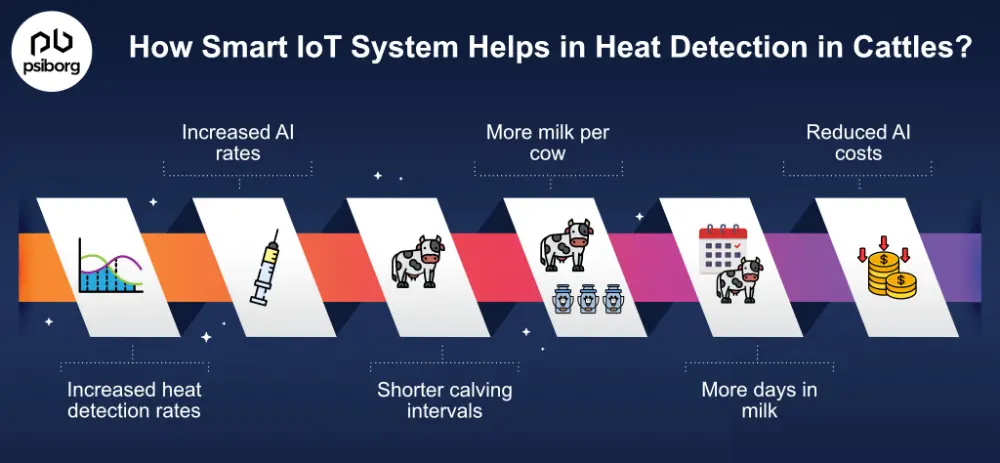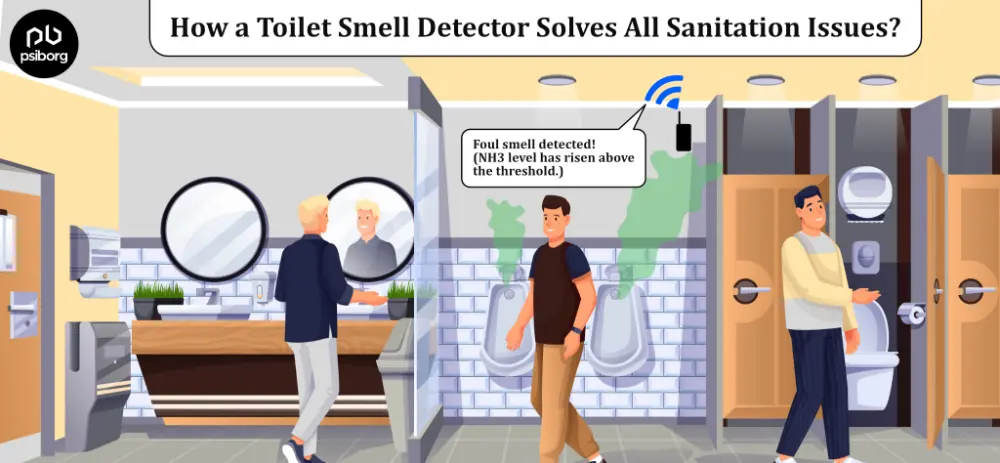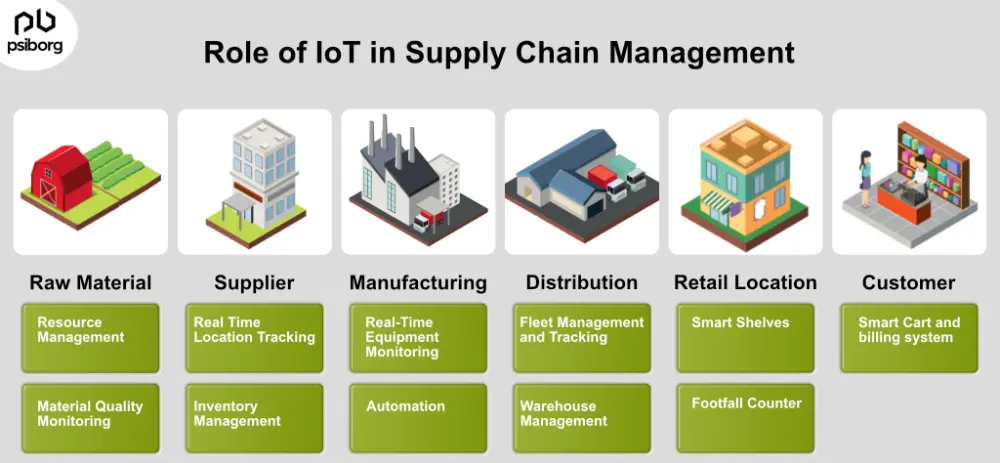We discuss a lot about the Internet of Things (IoT) but mostly its hardware aspect or the solutions. However, IoT solutions have two components: a device and an application.
In this article, we will dig deeper into understanding the software aspect of an IoT solution, more specifically, IoT web app development.
IoT Web Apps and Traditional Web Apps
Given the fact that web apps are an aspect of IT, you probably believe that web app development and IoT are entirely unrelated.
But, no IoT web app is one important aspect of an IoT solution, because it’s a User Interface through which the connected IoT devices are controlled and managed.
In the field of IoT, all the sensors and IoT devices are connected through the internet and so they all need a front-end and backend web application.
However, the IoT web app is a totally different game compared to the traditional web apps. The IoT web app communicates with the IoT hardware using MQTT and HTTP protocols.
Now, IoT-related service-providing companies are pushing web development to the next level.
This article discusses everything you should know about IoT web app development.
Let’s start by understanding IoT web apps.
What are IoT Web Apps?
IoT web apps are software applications that use the Internet of Things technology to improve functionality and uplift the user experience for the IoT device. IoT web apps are developed to view and analyze the data collected from an IoT device.
These web apps connect with IoT devices and the internet to offer features like remote monitoring, real-time tracking, and predictive maintenance alerts.
Moreover, the major reason to develop an IoT web app is to improve the productivity and convenience of device usage that can benefit both the manufacturer and the users.
Nevertheless, there are two types of web apps used in the IoT field viz- hybrid cloud models and embedded server standalone models.
Here, the hybrid model is a combination of the SaaS web application and the embedded device web application that runs on the firmware. The data is synchronized from the vendor’s cloud to the embedded device through the local network of the device.
However, the embedded device’s web applications are carried out entirely within the device’s firmware using an embedded web server. There are no external dependencies.
Impact of Web App Development on IoT Solutions
In the field of IoT, web apps connect the physical world (IoT devices) and virtual world (app) and that’s the reason why IoT web app development has gained so much attention.
We are surrounded by various devices such as TVs, refrigerators, kitchen appliances, wristwatches, and mobile phones.
By integrating IoT into these devices, they have now become smart TVs, Smart fridges, Smart kitchen appliances, Smartwatches, and smartphones.
For example, when we ask Alexa to do something, it triggers and gathers information from us, which it then interprets and processes to show on the screen.
To utilize the power of apps, these devices can also be connected to smartphones.
Major Components of an IoT System
Before we explain further about IoT web apps, let’s have a quick glance at an IoT system to understand where IoT web apps stand and why they are of so much importance.
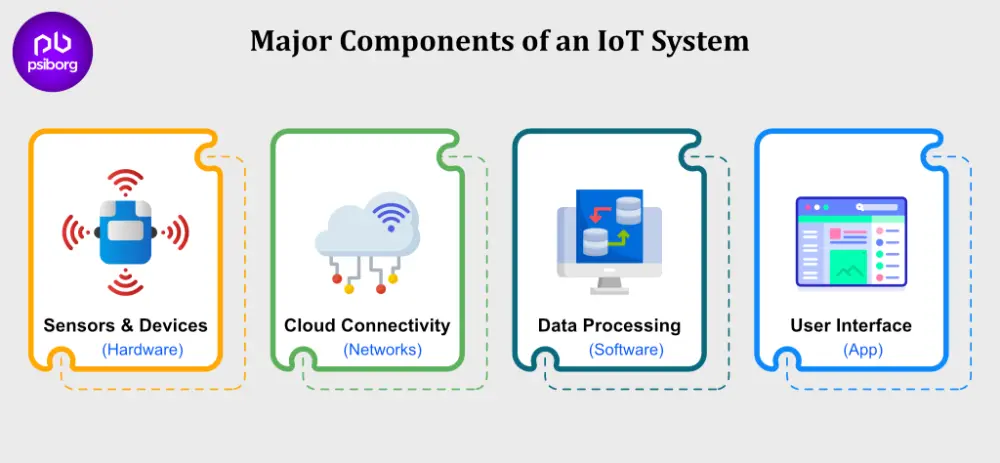
An IoT System consists of 4 major components:
- Sensors & Devices (Hardware)
- Cloud Connectivity (Networks)
- Data Processing (Software)
- User Interface (App)
So, sensors are the very first component of an IoT system. Its role is to gather relevant data.
Cloud connectivity is needed to share the data with the cloud infrastructure and store the data in the cloud. Wi-Fi, WAN, cellular, and satellite are utilized for connectivity.
Once the data is stored on the cloud, it is aggregated and refined through data processing. It’s done to extract something valuable from the huge amount of collected data.
In the end, when the whole data is organized and prepared, it is synced with the user interface, i.e., a web application.
Important Points To Consider While Developing An IoT Web Application
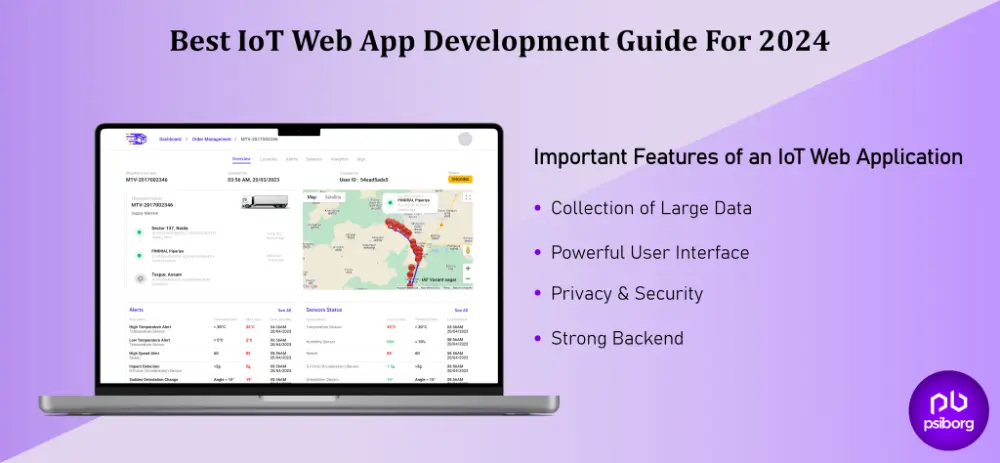
Now we know that IoT devices can have a much better interface when they are connected to a web app.
So, some of the important factors that should be considered while developing an IoT web app are:
1. Collection of Large Data
IoT devices collect huge amounts of data in real-time and send it to the backend. That’s why the related web app should be scalable. It should be capable of handling huge amounts of data and also should be able to process it at the same time.
For instance, in IoT-based health monitoring, the web application needs to be robust because the vital parameter data that IoT devices gather is crucial. We can’t lose or delay data here because of the network’s capabilities.
Such requirements increase the complexity of an IoT web app. That’s why we say an IoT web app is entirely different from a traditional web app.
2. Powerful User Interface
Since IoT devices gather data in real-time, it becomes more important to build a dynamic UI.
To explain, the ECG monitoring system needs to render the heartbeat of the users every second. So, the UI should handle the frequent changes very smoothly.
React has this concept of virtual DOM through which only the affected UI component is rendered, and all other UI is kept the same. This will help in updating the UI without reloading the entire page.
3. Privacy & Security
The biggest concern related to any IoT system is data security and privacy. In present times, half the research in the field of IoT is focused on security and privacy.
All the data from an IoT device goes to a web app through the internet, and if someone does a middle attack, all the data will be compromised.
That is why, there is a need to build an authentication and authorization feature in the web application, as it will secure the web app against any breach.
Nonetheless, data encryption also needs to be done before sending data from the IoT device to increase the security level.
4. Strong Backend
The best of an IoT device can only be extracted if the backend is strong. As we said, there is huge data, so the backend should be capable of handling large data requests and responding to them in real time.
Because the entire concept of IoT revolves around real-time monitoring and tracking. A strong backend is necessary for the same.
Take the example of an IoT based inventory management system. If the installed IoT device detects a low stock level of goods in inventory, it should automatically send an alert and order the item.
This kind of seamless inventory management system is only possible through IoT technology, which is complemented by a fully responsive, strong IoT web app.
IoT Web App vs. IoT Mobile App

IoT web apps are developed to run the application on various devices be it PCs, mobile phones, or tablets.
However, IoT mobile apps are developed and tuned for mobile phones, such as Android or Apple.
IoT web apps always need internet connectivity, while mobile apps are designed to work even without an internet connection.
Also, an IoT web app can be flexible for applications that need to be updated regularly. These IoT web apps always offer business process advantages for tech professionals who want to extract value from data-driven insights.
For instance, in the supply chain and logistics industries, many people are involved in every single stage of the process, like truck drivers, planners, dispatchers, or business managers.
They all need real-time insights to act accordingly.
Different user roles can be created using IoT web apps, giving access to the data according to the role. Such as the IoT admin dashboard gives business managers access to all the data about the supply chain task, allowing them to keep an eye on it all. Similar to this, the user dashboard gives access to different users at every stage of the supply chain, allowing them to track and optimize the particular tasks assigned to them.
This real-time control approach best fits an IoT web app.
Also, unlike mobile apps, there is no need to install web apps on the device. Web applications are always pretty easy to maintain, with no compatibility issues across platforms and browsers.
Custom Build vs. Off-the-Shelf IoT App
Once you have decided to get an IoT web app for your IoT solution, the next thing is to choose whether to build a custom IoT web app or take an Off-the-Shelf IoT app and just make little changes specific to the solution.
Custom-Built IoT Web App
PROS | CONS |
1. Fully customised solution built to meet specific business needs and requirements. 2. Gives full control over the features and functionalities. 3. Custom IoT web apps can integrate seamlessly with existing systems and devices. 4. Custom-built web apps allow for the implementation of innovative features tailored to the business. 5. Your own servers and data safety. 6. Independency from another business’s policies and pricing | 1. Higher development cost 2. Dependency on the development team |
Off-the-Shelf IoT Web App
PROS | CONS |
1. It requires a lower initial investment compared to custom solutions. 2. It offers quick deployment, allowing businesses to start using the application immediately. 3. Off-the-shelf solutions are suitable for common use cases. 4. Quick deployment of off-the-shelf solutions saves time and resources | 1. Off-the-shelf solutions offer limited customization options, restricting the ability to tailor features. 2. These solutions offer limited scalability and customization options. 3. These solutions are not adaptable to unique business requirements. 4. User relies on the vendor to introduce new features and updates. 5. Risk of data leaks 6. Constant payments |
Final Thoughts,
In modern IoT solutions, web apps play an integral role. So, IoT web app development has become increasingly impactful in our daily lives.
Hopefully, this article on IoT web app development should have given you all the information you needed to understand the subject.
Developing an IoT web application starts with a good idea, and the next step is to find a team to help you turn your idea into reality. If these two things are done perfectly, developing an IoT web application will be a success for you.
Now, we at PsiBorg might not help you with a business idea, but we can be of great value in the second step.
Being an IoT development service-providing company, we are very well aware of the intricacies of IoT app development and hold extensive experience in the same.
So get in touch with us, share your requirements, and let’s talk about how we can support your business idea.
Thank you for reading!
FAQs
An IoT web app is a software application that enables users to interact with and remotely control Internet of Things (IoT) devices via a web browser. The aforementioned web app enables the monitoring, management, and automation of connected devices via the Internet.
When it comes to developing custom IoT solutions and IoT web apps, PsiBorg Technologies is considered a prominent player.
PsiBorg Technologies is an end-to-end IoT solution-providing company that develops software, firmware, and IoT hardware solutions for businesses across all sectors.



